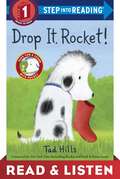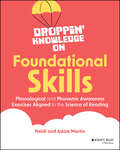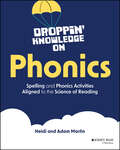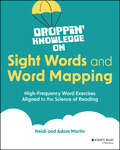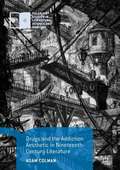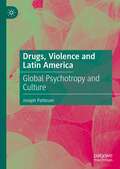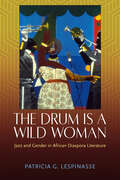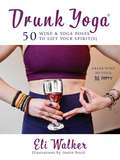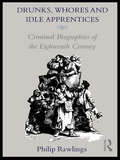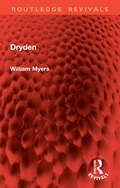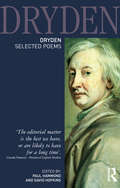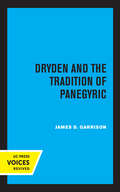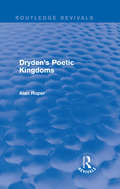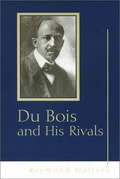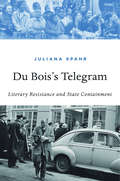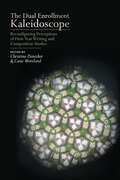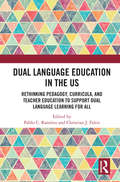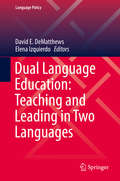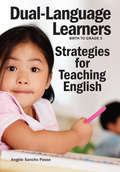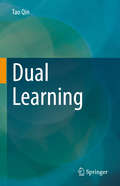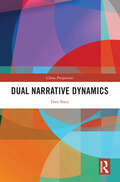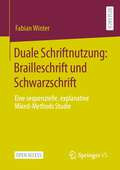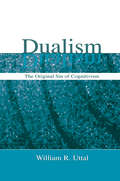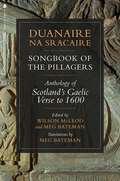- Table View
- List View
Drop It, Rocket!: Read & Listen Edition (Rocket)
by Tad HillsRocket, the beloved dog from the New York Times bestselling picture books How Rocket Learned to Read and Rocket Writes a Story, is back in a leveled reader. Rocket is ready to find new words for his word tree with his teacher, the little yellow bird. He finds a leaf, a hat, and a star . . . but when he finds a red boot, he doesn&’t want to let go. What will make Rocket drop it? With predictable patterns, simple words, lots of repetition, and bright, colorful illustrations, young readers will love this new Rocket book, which they can read all by themselves!This Read & Listen edition contains audio narration.
Droppin' Knowledge on Foundational Skills: Phonological and Phonemic Awareness Exercises Aligned to the Science of Reading
by Heidi Martin Adam MartinFun activities, games, and tips to teach phonics to kids, written by teachers and backed by research Droppin' Knowledge on Foundational Skills: Phonological and Phonemic Awareness Exercises Aligned to Science of Reading is an essential companion for anyone teaching kids how to read, showing exactly what works, why it works, and how to do it. Written by Heidi and Adam Martin, two veteran teachers and popular education influencers determined to solve the literacy crisis, this book distills the latest research in the science of phonological and phonemic awareness and makes it accessible to all, regardless of experience or depth of formal training. In this book, readers will explore: Word awareness, syllables, rhyming, onset and rime, phonemic isolation, blending, segmentation, addition, and deletion Practical strategies and tips to get kids ready to ensure kids have the foundational literacy skills they need to be successful readers and spellers Fun reproducibles and games that can be used as warm-ups and supplementary material to lesson plans Droppin' Knowledge on Foundational Skills: Phonological and Phonemic Awareness Exercises Aligned to Science of Reading earns a well-deserved spot on the bookshelves of all elementary and middle school teachers, literary coaches, reading specialists and tutors, and parents.
Droppin' Knowledge on Phonics: Spelling and Phonics Activities Aligned to the Science of Reading
by Heidi Martin Adam MartinReproducible, research-based activities to help K-5 students learn phonics and spelling, fast Educators and parents know we are facing a literacy crisis, but few know what to about it. Droppin' Knowledge on Phonics is an action-oriented guide written by experienced educators to bridge the gap between research and practice. Drawing on the latest evidence on how K-8 students learn best, Heidi Martin and Adam Martin have developed reproducible activities, games, and practical tips to bolster phonics and spelling curricula. All the books in the Droppin' Knowledge series contain ready-to-go resources that you can use within your existing curriculum. These activities are perfect as warm-ups, homework, extra credit assignments, or in-class additions to your lesson plans. Deepen learners' understanding of important phonics and spelling concepts and give them “quick wins” to increase confidence and activate prior learning. Many Science of Reading books go into too much detail on the research background of teaching. For parent educators and teachers, Droppin' Knowledge on Phonics offers a more accessible, immediately useful resource. With this book, you can teach students to read and help struggling readers, without a lot of background reading or ramp-up time. Find evidence-based reproducible activities that you can use right away to help students learn to read Bolster your lesson plans with no-prep activities, games, and homework assignments Get phonics and spelling activities to enhance your lessons Bring the latest scientific evidence into your teaching, without a lot of background reading or extra planning Anyone teaching students in grades K–5, including homeschooling parents and early career teachers, can easily implement the activities and techniques in this book. Reading specialists and literacy coaches will also appreciate this valuable, step-by-step resource library.
Droppin' Knowledge on Sight Words and Word Mapping: High-Frequency Word Exercises Aligned to the Science of Reading
by Heidi Martin Adam MartinTeacher-created activities, games, and tips aligned with science to help kids learn to read Created by a team of experienced teachers, not researchers, and aligned with the latest in the science of reading, Droppin' Knowledge on Sight Words: Strategies, Games, and Resources Aligned to the Science of Reading is a fun, actionable book that supports anyone teaching kids how to read. The research-based strategies included in this book take the focus off basic memorization and encourage kids to learn and permanently store high frequency words, while also reducing stress for parents, teachers, and kids throughout the reading process. Readers will find: Games that teach sight words (including heart words) through orthographic mapping Ready-to-use “quick win” activities perfect for bell work, homework, lesson plans, and extra credit assignments to deepen understanding and complement reading curriculum Practical tips and teaching strategies that help teach high frequency words in a more entertaining and effective way Addressing the literacy crisis in a way that kids find relatable and enjoyable, Droppin' Knowledge on Sight Words: Strategies, Games, and Resources Aligned to the Science of Reading is an essential handbook for K-5 teachers, reading specialists, and literacy coaches, along with reading tutors and all parents seeking to improve their child's literacy skills.
Drugs and the Addiction Aesthetic in Nineteenth-Century Literature (Palgrave Studies in Literature, Science and Medicine)
by Adam ColmanThis book explores the rise of the aesthetic category of addiction in the nineteenth century, a century that saw the development of an established medical sense of drug addiction. Drugs and the Addiction Aesthetic in Nineteenth-Century Literature focuses especially on formal invention—on the uses of literary patterns for intensified, exploratory engagement with unattained possibility—resulting from literary intersections with addiction discourse. Early chapters consider how Romantics such as Thomas De Quincey created, with regard to drug habit, an idea of habitual craving that related to self-experimenting science and literary exploration; later chapters look at Victorians who drew from similar understandings while devising narratives of repetitive investigation. The authors considered include De Quincey, Percy Shelley, Alfred Tennyson, Christina Rossetti, Charles Dickens, Robert Louis Stevenson, and Marie Corelli.
Drugs, Violence and Latin America: Global Psychotropy and Culture
by Joseph PattesonThis book undertakes a psychotropic analysis of texts that deal with the violence of drug trafficking and interdiction, especially in Mexico. While most critics of so-called narcoculture have either focused on an aesthetic “sobriety” in these works or discounted them altogether as exploitative and unworthy of serious attention, Drugs, Violence, and Latin America illuminates how such work may reflect and intervene in global networks of intoxication. Theorizing a “dialectics of intoxication” that illustrates how psychotropy may either solidify or destabilize the self and its relationship to the other, it proposes that these tendencies influence human behavior in distinct ways and are leveraged for social control within both licit and illicit economies. A consideration of a countercultural genealogy in Latin America provides a contrastive psychotropic context for contemporary novels that exposes links between narcoviolence and consumerism, challenging our addictions of thought and feeling about ourselves and our relationships to drugs and narco-violence.
The Drum Is a Wild Woman: Jazz and Gender in African Diaspora Literature
by Patricia G. LespinasseIn 1957, Duke Ellington released the influential album A Drum Is a Woman. This musical allegory revealed the implicit truth about the role of women in jazz discourse—jilted by the musician and replaced by the drum. Further, the album’s cover displays an image of a woman sitting atop a drum, depicting the way in which the drum literally obscures the female body, turning the subject into an object. This objectification of women leads to a critical reading of the role of women in jazz music: If the drum can take the place of a woman, then a woman can also take the place of a drum. The Drum Is a Wild Woman: Jazz and Gender in African Diaspora Literature challenges that image but also defines a counter-tradition within women’s writing that involves the reinvention and reclamation of a modern jazz discourse. Despite their alienation from bebop, women have found jazz music empowering and have demonstrated this power in various ways. The Drum Is a Wild Woman explores the complex relationship between women and jazz music in recent African diasporic literature. The book examines how women writers from the African diaspora have challenged and revised major tropes and concerns of jazz literature since the bebop era in the mid-1940s. Black women writers create dissonant sounds that broaden our understanding of jazz literature. By underscoring the extent to which gender is already embedded in jazz discourse, author Patricia G. Lespinasse responds to and corrects narratives that tell the story of jazz through a male-centered lens. She concentrates on how the Wild Woman, the female vocalist in classic blues, used blues and jazz to push the boundaries of Black womanhood outside of the confines of respectability. In texts that refer to jazz in form or content, the Wild Woman constitutes a figure of resistance who uses language, image, and improvisation to refashion herself from object to subject. This book breaks new ground by comparing the politics of resistance alongside moments of improvisation by examining recurring literary motifs—cry-and-response, the Wild Woman, and the jazz moment—in jazz novels, short stories, and poetry, comparing works by Ann Petry, Gayl Jones, Toni Morrison, Paule Marshall, Edwidge Danticat, and Maya Angelou with pieces by Albert Murray, Ralph Ellison, James Baldwin, and Ellington. Within an interdisciplinary and transnational context, Lespinasse foregrounds the vexed negotiations around gender and jazz discourse.
Drunk Yoga: 50 Wine & Yoga Poses to Lift Your Spirit(s)
by Eli Walker Justin PettitThe OFFICIAL Drunk Yoga book by the rebel behind the viral phenomenon!The Drunk Yoga craze is taking over… not even your bookshelf is safe! The official Drunk Yoga book includes 50 fun (and funny!) variations on traditional yoga poses including: Merlot-sana Vino-yasa WERK-Sasana Shot-a-runga Sip-da-Vino-sana Malbec-asana Bottle-konasana and so much more!In addition, you’ll learn the Drunk Yoga rules (so you don’t make any pour decisions), partner activities (so you won’t have to drink alone), hilarious fun facts, crazy stories from real Drunk Yoga classes, poems, drawings, and other fun surprises! Full of wine, yoga, jokes, and joy, Drunk Yoga is for the experienced yogi, the average barfly, the social butterfly, and the wallflower who needs a few sips of liquid courage. It’s about wine. And yoga. And not taking yourself too seriously. Already a huge hit for bachelor and bachelorette parties, birthday celebrations, and even office and team-building activities, this official book is founder Eli Walker’s newest way to bring Drunk Yoga to you, wherever you are.Drink wine. Do yoga. Be happy.
Drunks, Whores and Idle Apprentices: Criminal Biographies of the Eighteenth Century
by Philip RawlingsCriminal biographies enjoyed enormous popularity in the Eighteenth Century: today they offer us some fascinating perspectives on the period. Drunks, Whores and Idle Apprentices is the first book to reproduce a number of these biographies in full.Not only do these biographies make fascinating reading, they also raise the problem of how to read them as historical documents. The author argues that instead of trying to uncover simple themes, the most revealing thing about them is the tensions around which they were constructed.
Dryden (Routledge Revivals)
by null William MyersOriginally published in 1973, this is foremost a study of Dryden as a writer, but, the author maintains, his ideas cannot be separated from his art. Dryden’s concern with familiar 17th Century problems – the inadequacy of royalist theory in the face of power politics, the rise of philosophical materialism, make him almost as important to the historian as to the student of English Literature. William Myers’ overall picture of Dryden’s works ranges chronologically from the Restoration to the Glorious Revolution. Each play or poem is judged in its own right and as part of a strikingly honest literary life. Particular emphasis is given to the writings following The Hind and the Panther. Then at last Dryden was able to unite his total mastery of prose and verse both with a fully developed sense of what had happened to English society and with his own unyielding commitment to a traditional political philosophy and a traditional theology.
Dryden: Selected Poems (Longman Annotated English Poets)
by PAUL HAMMOND; DAVID HOPKINSDryden: Selected Poems is drawn from Paul Hammond and David Hopkins's remarkable five-volume The Poems of John Dryden, and includes a generous selection of his most important work. The great satires, MacFlecknoe and Absalom and Achitophel, are included in full, as are his religious poemsReligio Laici and The Hind and the Panther, along with a number of Dryden's translations from Horace, Ovid, Homer, and Chaucer. Each poem is accompanied by a headnote, which gives details of composition, publication, and reception. The first-rate annotations provide information on matters of interpretation and give details of allusions that might prove baffling to contemporary readers. Some 300 years after his death, Dryden: Selected Poems will enable new generations of readers to discover the poet of whom Eliot wrote: 'we cannot fully enjoy or rightly estimate a hundred years of English poetry unless we fully enjoy Dryden'.
Dryden and the Tradition of Panegyric
by James GarrisonThis title is part of UC Press's Voices Revived program, which commemorates University of California Press’s mission to seek out and cultivate the brightest minds and give them voice, reach, and impact. Drawing on a backlist dating to 1893, Voices Revived makes high-quality, peer-reviewed scholarship accessible once again using print-on-demand technology. This title was originally published in 1975.
Dryden's Poetic Kingdoms (Routledge Revivals)
by Alan RoperDr. Roper describes the mode of many of Dryden’s original poems by redefining the royalism that provides the matter of some works and the metaphoric vocabulary of others. Dryden’s royalism is seen both as an identifiable political attitude and a way of apprehending public life that again and again relates superficially non-political matters to the standards and assumptions of politics in order to determine their public significance. Dryden’s Poetic Kingdoms, first published in 1965, principally through readings of ten poems, comes to the conclusion that Dryden’s poems are most successful when they work to create a meaningful analogy between such topics as literature and politics or between the constitution of England and the constitution of Rome, the Garden of Eden, or Israel under David.
Du Bois and his Rivals
by Raymond WoltersAlthough focusing primarily on W. E. B. Du Bois, this book gives biagraphical information and criticisms of a few Civil Rights leaders, including Booker T. Washington and Marcus Garvey. It describes the similarities and differences between these men's views.
Du Bois’s Telegram: Literary Resistance and State Containment
by Juliana SpahrTaking her cue from W. E. B. Du Bois, Juliana Spahr explores how state interests have shaped U.S. literature. What is the relationship between literature and politics? Can writing be revolutionary? Can art be autonomous or is escape from nations and nationalisms impossible? As her sobering study affirms, aesthetic resistance is easily domesticated.
The Dual Artist Novel: Subverting Genre and Gender
by Orla Siobhán FlockThe artist novel occupies a prominent place in literary history. Although research into this genre, which is usually perceived as especially rigid, may seem to be exhausted at a first glance, a closer look at the development of the artist novel reveals its sheer incomparable malleability and resilience. In this book Orla Flock turnes her attention to those types of artist novels, which she calls dual artist novels, which depict the artistic and personal development of both a male and a female artist. The juxtaposition of the male and the female artist narratives reveals both the rootedness of the genre in literary tradition and subverts established but outdated notions of genre and gender. On both a structural and a narrative level, the dual artist novel challenges established but confining views and demonstrates that even incremental, nuanced development over time can ultimately lead to vast transformation. By reshaping the formerly rigid genre of the artist novel to include numerous and diverse voices while staying true to the thematic tradition, the dual artist novel subverts both the notion of static genre definitions as well as limiting conceptions of gender.
The Dual Enrollment Kaleidoscope: Reconfiguring Perceptions of First-Year Writing and Composition Studies
by Christine Denecker Casie MorelandThe Dual Enrollment Kaleidoscope serves as a starting point for elevating the voices of those who do dual enrollment (DE) work—those who historicize, legitimize, scrutinize, critically analyze, align, and assess it—pushing readers beyond unique, singular views of DE first-year composition and positioning DE’s impact on composition instruction as one that shifts dependent upon perspective. Just as kaleidoscopes reconfigure images, DE provides writing studies with reflecting images of what FYC was, is, and could be. DE disrupts long-held beliefs of who should take and who should teach college writing. Giving higher education pause about the place of writing instruction within the academy, DE force those in the field to reflect upon the purposes and value of FYC and its pedagogical approaches. Featuring seventeen chapters written by a wide and diverse range of authors, this collection includes the voices of prominent scholars in rhetoric and composition at two- and four-year public and private institutions, as well as emerging scholars in the field. It also features a variety of methodologies, including archival research, quantitative and qualitative data collection, and autoethnography. Few texts have been published on dual enrollment writing in rhetoric and composition studies. The Dual Enrollment Kaleidoscope should be mandatory reading for anyone interested in or tasked with doing the work of DE writing instruction, administration, mentoring, or assessment. Contributors: Dominic Ashby, Anna Bogen, Tyler Branson, Melanie Burdick, Scott Campbell, Christine R. Farris, David Gehler, Leigh Graziano, Jane Greer, Jennifer Hadley, Jacquelyn Hoermann-Elliott, Joseph Jones, Nancy Knowles, Amy Lueck, Miles McCrimmon, Katie McWain, Annie S. Mendenhall, Keith Miller, Brice Nordquist, Cornelia Paraskevas, Jill Parrot, Shirley K Rose, Barbara Schneider, Erin Scott-Stewart
Dual Language Education in the US: Rethinking Pedagogy, Curricula, and Teacher Education to Support Dual Language Learning for All (Routledge Research in Language Education)
by Pablo C. Ramírez Christian J. FaltisOriginally published as a special issue of the journal Theory into Practice, this text examines innovative practices and research relating to Dual Language Education (DLE) in the US. Offering a variety of perspectives, contributors consider how dual language learning can benefit English-speaking and partner-language students across K-12, and explore how multilingualism can be harnessed for wider academic success. By investigating the ways in which schools and teachers have ensured provision of an effective DLE curriculum, chapters identify pedagogies and learning environments which support dual language learning, and consider how policy, curricula, and teacher education can be designed to promote social justice and diversity through broader access to dual programs. This book will be of interest to graduate and post graduate students, researchers, academics, professionals and policy makers in the field of multicultural education, international & comparative education, bilingualism studies, education policy and pedagogy.
Dual Language Education: Teaching and Leading in Two Languages (Language Policy #18)
by Elena Izquierdo David E. DeMatthewsThis book provides a comprehensive and interdisciplinary examination of dual language education for Latina/o English language learners (ELLs) in the United States, with a particular focus on the state of Texas and the U.S.-Mexico border. The book is broken into three parts. Part I examines how Latina/o ELLs have been historically underserved in public schools and how this has contributed to numerous educational inequities. Part II examines bilingualism, biliteracy, and dual language education as an effective model for addressing the inequities identified in Part I. Part III examines research on dual language education in a large urban school district, a high-performing elementary school that serves a high proportion of ELLs along the Texas-Mexico border, and best practices for principals and teachers.This volume explores the potential and realities of dual language education from a historical and social justice lens. Most importantly, the book shows how successful programs and schools need to address and align many related aspects in order to best serve emergent bilingual Latino/as: from preparing teachers and administrators, to understanding assessment and the impacts of financial inequities on bilingual learners. Peter Sayer, The Ohio State University, USA
Dual-Language Learners
by Angèle Sancho PasseGrowing research shows that many children from immigrant and refugee families are not doing well in school, due in part to linguistic and cultural disadvantages. Teaching dual-language learners requires cultural sensitivity, an understanding of language acquisition, and intentional teaching strategies. Combining research and techniques, this resource helps early childhood educators support dual-language learners as they develop the skills necessary for school readiness and success.Angèle Sancho Passe, an early childhood education consultant and writer, is trilingual and has worked with many programs serving dual-language learners. She is the author of Is Everybody Ready for Kindergarten?
Dual Learning
by Tao QinMany AI (and machine learning) tasks present in dual forms, e.g., English-to-Chinese translation vs. Chinese-to-English translation, speech recognition vs. speech synthesis,question answering vs. question generation, and image classification vs. image generation. Dual learning is a new learning framework that leverages the primal-dual structure of AI tasks to obtain effective feedback or regularization signals in order to enhance the learning/inference process. Since it was first introduced four years ago, the concept has attracted considerable attention in multiple fields, and been proven effective in numerous applications, such as machine translation, image-to-image translation, speech synthesis and recognition, (visual) question answering and generation, image captioning and generation, and code summarization and generation. Offering a systematic and comprehensive overview of dual learning, this book enables interested researchers (both established and newcomers) and practitioners to gain a better understanding of the state of the art in the field. It also provides suggestions for further reading and tools to help readers advance the area. The book is divided into five parts. The first part gives a brief introduction to machine learning and deep learning. The second part introduces the algorithms based on the dual reconstruction principle using machine translation, image translation, speech processing and other NLP/CV tasks as the demo applications. It covers algorithms, such as dual semi-supervised learning, dual unsupervised learning and multi-agent dual learning. In the context of image translation, it introduces algorithms including CycleGAN, DualGAN, DiscoGAN cdGAN and more recent techniques/applications. The third part presents various work based on the probability principle, including dual supervised learning and dual inference based on the joint-probability principle and dual semi-supervised learning based on the marginal-probability principle. The fourth part reviews various theoretical studies on dual learning and discusses its connections to other learning paradigms. The fifth part provides a summary and suggests future research directions.
Dual Narrative Dynamics (China Perspectives)
by Dan ShenCombining narratological and stylistic methods, this book theorizes dual narrative dynamics comprised of plot development and covert progression, and demonstrates the consequences for the interpretation of literary works.In narratives with such dynamics, writers work simultaneously with overt and covert trajectories of signification, establishing a range of relationships between them. The two parallel narrative movements may complement, contradict or even subvert each other, and these relationships significantly influence readers’ understanding not just of events but also of characters, themes, and aesthetic values. The book provides a systematic theoretical account of such previously neglected dual narrative dynamics, substantiated and enriched by the textual analysis of works by Ambrose Bierce, Kate Chopin, Franz Kafka, and Katherine Mansfield. The study explores the many ways that these authors have used dual dynamics to increase the power of their narratives. In addition, the book identifies the challenges such dual dynamics present not only for narratology but also for stylistics and translation studies, and it develops sound and provocative proposals for meeting those challenges.In taking an interdisciplinary approach, this book will appeal to scholars and students in the fields of narrative and literary theory, literary criticism, literary stylistics, and translation studies.
Duale Schriftnutzung: Eine sequenzielle, explanative Mixed-Methods Studie
by Fabian WinterIn diesem Open-Access-Buch werden die schriftsprachlichen Kompetenzen von Schülerinnen und Schülern mit dualer Schriftnutzung untersucht. Von einem dualen Schriftspracherwerb spricht man, wenn Kinder oder Jugendliche mit Sehbeeinträchtigung neben der Schwarzschrift auch die Brailleschrift erlernen. Vom Erwerb eines zusätzlichen Schriftmediums profitieren insbesondere Lernende mit fortschreitenden oder schwerwiegenden Augenerkrankungen. Wie wirkt sich ein dualer Schriftspracherwerb auf die Leseflüssigkeit, die Rechtschreibung bzw. das Lese- und Hörverstehen aus? Wie können Kinder und Jugendliche mit dualer Schriftnutzung gefördert werden? Um diese Fragen zu beantworten, werden die Ergebnisse aus einer Kompetenzerhebung sowie mehreren Fallstudien herangezogen und mit dem aktuellen Kenntnis- und Forschungsstand zur dualen Schriftnutzung verknüpft. Dazu werden praktische und anschauliche Beispiele geliefert, wie der Unterricht von Kindern und Jugendlichen mit dualer Schriftnutzung gelingen kann.
Dualism: The Original Sin of Cognitivism
by William R. UttalDirected to scholars and senior-level graduate students, this book is an iconoclastic survey of the history of dualism and its impact on contemporary cognitive psychology. It argues that much of modern cognitive or mentalist psychology is built upon a cryptodualism--the idea that the mind and brain can be thought of as independent entities. This dualism pervades so much of society that it covertly influences many aspects of modern science, particularly psychology. To support the argument, the history of dualism is extended over 100,000 years--from the Paleolithic times until modern philosophical and psychological thinking. The questions regarding this topic that are answered in the book are: 1) Does dualism influence the scientific theories of psychology? 2) If so, should dualism be put aside in the search for a more objective analysis of human mentation?
Duanaire Na Sracaire: Anthology of Medieval Gaelic Poetry
by Wilson McLeod and Meg BatemanThe definitive Gaelic-English anthology of medieval Scottish verse: an annotated treasure trove of literary history spanning a millennium. Duanaire na Sracaire—or Songbook of the Pillagers—is the first anthology to bring together Scotland&’s Gaelic poetry from c.600-1600 AD, a time when Scotland shared its rich culture with Ireland. It includes a huge range of diverse poetry: prayers and hymns of Iona, Fenian lays, praise poems and satires, courtly songs and lewd rants, songs of battle and death, incantations and love poems. All poems appear with facing-page translations which capture the spirit and beauty of the originals and are accompanied by detailed notes. A comprehensive introduction sets the context and analyses the role and functions of poetry in Gaelic society. This collection will appeal to poetry lovers, Gaelic speakers and those keen to explore a vital part of Scotland&’s literary heritage.
